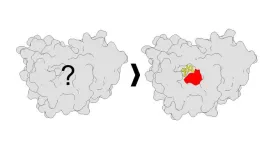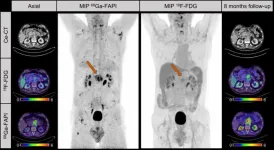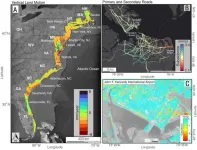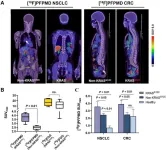(Press-News.org) LA JOLLA, CA—Identifying new ways to target proteins involved in human diseases is a priority for many researchers around the world. However, discovering how to alter the function of these proteins can be difficult, especially in live cells. Now, scientists from Scripps Research have developed a new method to examine how proteins interact with drug-like small molecules in human cells—revealing critical information about how to potentially target them therapeutically.
The strategy, published in Nature Chemical Biology on January 2, 2024, uses a combination of chemistry and analytical techniques to reveal the specific places where proteins and small molecules bind together. Ultimately, this method could lead to the development of more targeted and effective therapeutics.
“Our new technology could be used to find new druggable sites on proteins for any human disease, from cancer to Alzheimer’s disease,” says associate professor, Department of Chemistry Christopher Parker, PhD, senior author of the study. “We’re unrestricted in how this could be used. Our work has the potential to usher in a whole new way of drug discovery.”
The Parker lab aims to discover how proteins function in every human cell type to develop effective therapeutics for a wide range of human diseases. In this study, Parker and his team built off his initial work in the lab of Scripps Research professor Benjamin Cravatt to create a new method of examining how proteins interact with small molecules in living cells. They developed an analytical strategy to better understand how these proteins engage with small molecules at much higher resolution than ever before. To do this, they used chemical probes called photoaffinity probes, which are molecules that can be activated by light to allow the probes to capture a bound protein.
By gathering data from the interactions of proteins with photoaffinity probes, the Parker team identified locations on proteins where small molecules could connect and bind. Essentially, the team found over a thousand new locks (binding sites on the proteins) and corresponding keys (small molecules), the vast majority of which were new places of small-molecule binding that had not been reported before. Additionally, they found new features of the binding sites–such as new shapes.
“Identifying these specific binding sites will help scientists design new molecules that fit these pockets even better, potentially leading to more effective therapeutics,” says Jacob M. Wozniak, co-first author, and former postdoctoral fellow in the Parker lab. The other co-first author of the paper was Weichao Li, PhD, a research associate also in the Parker lab.
Using the wealth of data in this study and collaborating with co-author Stefano Forli, PhD, associate professor in the Department of Integrative Structural and Computational Biology, the authors then modeled how certain molecules might bind to these proteins. This library of information could be used to design therapeutics that interact with proteins in a more targeted way.
“Our new process reveals additional opportunities for therapeutic intervention and discovery in human cells,” says Parker. “Next, we plan to use this technology to target proteins relevant for autoimmune diseases and cancer.”
Authors of the study, “Enhanced Mapping of Small Molecule Binding Sites in Cells” include Jacob M. Wozniak, Weichao Li, Paolo Governa, Li-Yun Chen, Appaso Jadhav, Stefano Forli and Christopher G. Parker of Scripps Research; and Ashok Dongre of Bristol-Myers Squibb.
This work was supported by finding from the National Institute of Allergic and Infectious Diseases (R01 AI156258, 1U19AII71443-0, and T32AI007244) and National Institutes of Health (R01GM069832).
About Scripps Research
Scripps Research is an independent, nonprofit biomedical institute ranked one of the most influential in the world for its impact on innovation by Nature Index. We are advancing human health through profound discoveries that address pressing medical concerns around the globe. Our drug discovery and development division, Calibr, works hand-in-hand with scientists across disciplines to bring new medicines to patients as quickly and efficiently as possible, while teams at Scripps Research Translational Institute harness genomics, digital medicine and cutting-edge informatics to understand individual health and render more effective healthcare. Scripps Research also trains the next generation of leading scientists at our Skaggs Graduate School, consistently named among the top 10 US programs for chemistry and biological sciences. Learn more at www.scripps.edu.
END
New method illuminates druggable sites on proteins
Scripps Research scientists develop a new, high-resolution technique for finding potential therapeutic targets on proteins in living cells. The findings could lead to more targeted therapeutics for nearly any human disease.
2024-01-02
ELSE PRESS RELEASES FROM THIS DATE:
RSV vaccines would greatly reduce illness if implemented like flu shots
2024-01-02
Respiratory syncytial virus (RSV) vaccines recently approved for people 60 and older would dramatically reduce the disease’s significant burden of illness and death in the United States if they were widely adopted like annual influenza vaccines, a new study has found.
A high level of RSV vaccination would not only potentially reduce millions of dollars in annual outpatient and hospitalization costs but would also produce an economy of scale with individual shots being delivered at a relatively modest cost of between $117 and $245 per dose, the study said.
The vaccines are currently covered by most private insurers without ...
Ga-68 FAPI PET improves detection and staging of pancreatic cancer
2024-01-02
Reston, VA—PET imaging with 68Ga-FAPI can more effectively detect and stage pancreatic cancer as compared with 18F-FDG imaging or contrast-enhanced CT, according to new research published in the December issue of The Journal of Nuclear Medicine. In a head-to-head study, 68Ga-FAPI detected more pancreatic tumors on a per-lesion, per-patient, or per-region basis and led to major and minor changes to clinical management of patients. In addition to enhancing precise detection of pancreatic cancer, 68Ga-FAPI ...
Understanding climate mobilities: New study examines perspectives from South Florida practitioners
2024-01-02
Understanding Climate Mobilities: New study examines perspectives from South Florida practitioners
As climate change continues to impact people across South Florida, the need for adaptive responses becomes increasingly important.
A recent study led by researchers at the University of Miami Rosenstiel School of Marine, Atmospheric, and Earth Science, assessed the perspectives of 76 diverse South Florida climate adaptation professionals. The study titled, “Practitioner perspectives on climate mobilities in South Florida” was published in the December issue of the Journal Oxford Open Climate Change, and explores the expectations and concerns of practitioners from the ...
Study: From NYC to DC and beyond, cities on the East Coast are sinking
2024-01-02
Major cities on the U.S. Atlantic coast are sinking, in some cases as much as 5 millimeters per year – a decline at the ocean’s edge that well outpaces global sea level rise, confirms new research from Virginia Tech and the U.S. Geological Survey.
Particularly hard hit population centers such as New York City and Long Island, Baltimore, and Virginia Beach and Norfolk are seeing areas of rapid “subsidence,” or sinking land, alongside more slowly sinking or relatively stable ground, increasing the risk to roadways, runways, building foundations, rail ...
New PET tracer noninvasively identifies cancer gene mutation, allows for more precise diagnosis and therapy
2024-01-02
Reston, VA—A novel PET imaging tracer has been proven to safely and effectively detect a common cancer gene mutation that is an important molecular marker for tumor-targeted therapy. By identifying this mutation early, physicians can tailor treatment plans for patients to achieve the best results. This research was published in the December issue of The Journal of Nuclear Medicine.
Kirsten rat sarcoma (KRAS) is a commonly mutated oncogene that is present in approximately 20-70 percent of cancer cases. Patients with KRAS mutations usually respond poorly to standard therapies. As such, the National Comprehensive ...
Evolution might stop humans from solving climate change, says new study
2024-01-02
Central features of human evolution may stop our species from resolving global environmental problems like climate change, says a new study led by the University of Maine.
Humans have come to dominate the planet with tools and systems to exploit natural resources that were refined over thousands of years through the process of cultural adaptation to the environment. University of Maine evolutionary biologist Tim Waring wanted to know how this process of cultural adaptation to the environment might influence the goal of solving global environmental problems. ...
January issues of APA journals cover antidepressant outcomes, disparities in school-based support, civil commitment hearings, and more
2024-01-02
WASHINGTON, D.C., Jan 2, 2024 — The latest issues of three American Psychiatric Association journals, The American Journal of Psychiatry, Psychiatric Services and The American Journal of Psychotherapy are now available online.
The January issue of The American Journal of Psychiatry features studies focusing on improving clinical outcomes and informing new interventions. Highlights include:
Predicting Acute Changes in Suicidal Ideation and Planning: A Longitudinal Study of Symptom Mediators and the Role of the Menstrual ...
Memory, brain function, and behavior: exploring the intricate connection through fear memories
2024-01-02
In a world grappling with the complexities of mental health conditions like anxiety, depression, and PTSD, new research from Boston University neuroscientist Dr. Steve Ramirez and collaborators offers a unique perspective. The study, recently published in the Journal of Neuroscience, delves into the intricate relationship between fear memories, brain function, and behavioral responses. Dr. Ramirez, along with his co-authors Kaitlyn Dorst, Ryan Senne, Anh Diep, Antje de Boer, Rebecca Suthard, Heloise ...
Demystifying a key receptor in substance use and neuropsychiatric disorders
2024-01-02
New York, NY (January 2, 2024)—Researchers at the Icahn School of Medicine at Mount Sinai have uncovered insights into the potential mechanism of action of the antipsychotic medication asenapine, a possible therapeutic target for substance use and neuropsychiatric disorders. This discovery may pave the way for the development of improved medications targeting the same pathway.
Their findings, detailed in the January 2 online issue of Nature Communications https://doi.org/10.1038/s41467-023-44601-4, show that a brain protein known as the TAAR1 receptor, a drug target known to regulate dopamine signaling in key reward pathways in the brain, differs ...
Elusive cytonemes guide neural development, provide signaling ‘express route’
2024-01-02
St. Jude Children’s Research Hospital scientists found that cytonemes (thin, long, hair-like projections on cells) are important during neural development. Cytonemes connect cells communicating across vast distances but are difficult to capture with microscopy in developing vertebrate tissues. The researchers are the first to find a way to visualize how cytonemes transport signaling molecules during mammalian nervous system development. The findings were published in Cell.
“We showed cytonemes are a direct express route for signal transport,” said corresponding author ...
LAST 30 PRESS RELEASES:
Crystallographic engineering enables fast low‑temperature ion transport of TiNb2O7 for cold‑region lithium‑ion batteries
Ultrafast sulfur redox dynamics enabled by a PPy@N‑TiO2 Z‑scheme heterojunction photoelectrode for photo‑assisted lithium–sulfur batteries
Optimized biochar use could cut China’s cropland nitrous oxide emissions by up to half
Neural progesterone receptors link ovulation and sexual receptivity in medaka
A new Japanese study investigates how tariff policies influence long-run economic growth
Mental trauma succeeds 1 in 7 dog related injuries, claims data suggest
Breastfeeding may lower mums’ later life depression/anxiety risks for up to 10 years after pregnancy
Study finds more than a quarter of adults worldwide could benefit from GLP-1 medications for weight loss
Hobbies don’t just improve personal lives, they can boost workplace creativity too
Study shows federal safety metric inappropriately penalizes hospitals for lifesaving stroke procedures
Improving sleep isn’t enough: researchers highlight daytime function as key to assessing insomnia treatments
Rice Brain Institute awards first seed grants to jump-start collaborative brain health research
Personalizing cancer treatments significantly improve outcome success
UW researchers analyzed which anthologized writers and books get checked out the most from Seattle Public Library
Study finds food waste compost less effective than potting mix alone
UCLA receives $7.3 million for wide-ranging cannabis research
Why this little-known birth control option deserves more attention
Johns Hopkins-led team creates first map of nerve circuitry in bone, identifies key signals for bone repair
UC Irvine astronomers spot largest known stream of super-heated gas in the universe
Research shows how immune system reacts to pig kidney transplants in living patients
Dark stars could help solve three pressing puzzles of the high-redshift universe
Manganese gets its moment as a potential fuel cell catalyst
“Gifted word learner” dogs can pick up new words by overhearing their owners’ talk
More data, more sharing can help avoid misinterpreting “smoking gun” signals in topological physics
An illegal fentanyl supply shock may have contributed to a dramatic decline in deaths
Some dogs can learn new words by eavesdropping on their owners
Scientists trace facial gestures back to their source. before a smile appears, the brain has already decided
Is “Smoking Gun” evidence enough to prove scientific discovery?
Scientists find microbes enhance the benefits of trees by removing greenhouse gases
KAIST-Yonsei team identifies origin cells for malignant brain tumor common in young adults
[Press-News.org] New method illuminates druggable sites on proteinsScripps Research scientists develop a new, high-resolution technique for finding potential therapeutic targets on proteins in living cells. The findings could lead to more targeted therapeutics for nearly any human disease.








